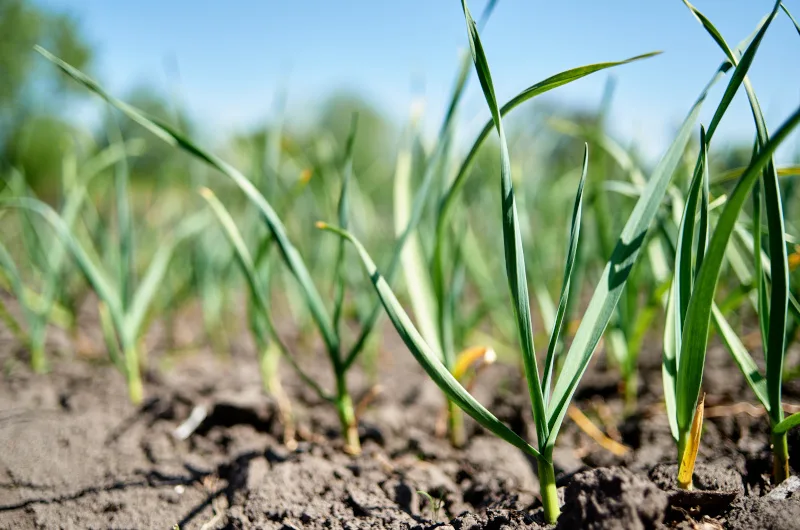How To Grow Garlic
Garlic, with its pungent aroma and distinctive flavour, is a staple ingredient in continental cookery, but now also a firm favourite in British cuisine. Growing your own garlic not only ensures a fresh supply but also allows you to savour the satisfaction of cultivating this versatile bulb in your garden. The guide below outlines how to grow and provides a few top tips to help ensure success.
Choosing Garlic Varieties
Select a garlic variety suitable for your region and growing conditions. Softneck varieties of garlic are well-suited to milder climates, while hardneck garlics are more tolerant of colder temperatures. Consider factors such as flavour, storage capability, and disease resistance when choosing your garlic bulbs. There’s even a type known as Elephant Garlic, which produces very large cloves – although technically, this is genetically closer in nature to leeks than true garlic.
Some people buy garlic from a supermarket or grocery store and use this as a source of cloves to grow. Whilst it’s entirely possible to grow in this manner, the results can be unpredictable. The cloves may come from a warmer climate and be a variety unsuitable for growing in the UK. It’s also possible they may contain disease spores. Supermarket garlic is cheaper than cloves supplied specifically for growing but, in our opinion, it’s a false economy when you take into account the risk of a failed crop, or introducing hard to shift garlic diseases such as white rot to your plot. Instead, we’d recommend buying proper horticultural quality cloves available from garden centres or mail order providers the first year, then saving a few of the resultant crop to sow in autumn for another crop the following summer. Another key benefit of buying proper horticultural cloves to grow is that there are some great garlic varieties, with subtly different crops suited to different culinary uses.
Preparing the Soil
Garlic thrives in well-draining soil rich in organic matter. Before planting, loosen the soil using a fork or spade, removing any rocks or weeds. Incorporate compost or well-rotted manure to improve soil fertility. Aim for a slightly acidic to neutral pH level of around 6.0 to 7.0. Handy tip – adding coffee grounds to alkaline soil can help make the soil more acidic.
Planting Garlic Cloves
Break apart the garlic bulbs into individual cloves, ensuring they remain intact with the papery skin. Plant the cloves in late autumn or early winter pointed end up, around 5 centimetres (2 inches) deep and spaced approximately 15 centimetres (6 inches) apart. Space rows around 30 centimetres (12 inches) apart to allow for adequate airflow.
It’s also possible to plant garlic in early spring, but overwintering tends to be the best method, as frost is needed to help the cloves split and produce new cloves. As the weather warms in the UK, spring frost is becoming much less dependable, particularly in the south. Overwintering also gives a better chance of producing nice, fat juicy cloves.
If you have particularly heavy soil, it can be best to plant the cloves into pots or modules in the autumn, over-wintering them in a cold frame or unheated greenhouse or polytunnel, then transplanting into their final location in the spring. This way you get the benefit of a long growing season, with less risk of the cloves rotting in wet, cold winters.
Providing Adequate Water
Garlic requires consistent moisture during its growing period. Once early summer arrives, keep an eye on moisture levels. If the weather is dry, water the garlic beds regularly, keeping the soil moist but not waterlogged. Reduce watering as the bulbs mature to prevent rot. During dry spells, increase watering to maintain optimal soil moisture.
Mulching and Weed Control
Apply a layer of organic mulch, such as straw or shredded leaves, around the garlic plants. Mulching helps conserve soil moisture, suppress weeds, and moderate soil temperature. Regularly remove any weeds that emerge near the garlic to minimize competition for nutrients and water.
Fertilising
Garlic benefits from a balanced fertiliser application. Apply a nitrogen-rich fertiliser, such as a slow-release organic fertiliser or well-diluted liquid fertiliser, during the early stages of growth. Avoid excessive nitrogen in the later stages, as it may promote leaf growth rather than bulb development.
Scaping and Harvesting
As the garlic plants grow, scapes (curly flower stalks) may appear. To encourage larger bulb growth, promptly remove these scapes by cutting them near the base. Harvest garlic when the lower leaves of the top growth turn yellow and dry, typically in mid to late summer. Gently loosen the soil around the bulbs, and carefully lift them with a fork.
Curing and Storing
After harvesting, allow the garlic bulbs to dry and cure in a well-ventilated, shaded area for several weeks. Hang them in bunches or spread them out on racks. Once the outer layers have dried and the bulbs feel firm, trim the roots and store them in a cool, dark, and dry place. Properly cured garlic can last for several months.
Growing your own garlic is a gratifying endeavor that rewards you with an abundant supply of flavourful bulbs. By following these steps, from selecting the right varieties to harvesting and storing your crop, you can enjoy the aromatic delights of homegrown garlic in your culinary creations.




One thought on “How To Grow Garlic”